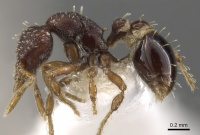Strumigenys phasma
| Strumigenys phasma | |
|---|---|

| |
| Scientific classification | |
| Kingdom: | Animalia |
| Phylum: | Arthropoda |
| Class: | Insecta |
| Order: | Hymenoptera |
| Family: | Formicidae |
| Subfamily: | Myrmicinae |
| Tribe: | Attini |
| Genus: | Strumigenys |
| Species: | S. phasma |
| Binomial name | |
| Strumigenys phasma (Bolton, 2000) | |
The only known collection was from a rotten log in a montane rainforest.
Identification
Bolton (2000) - A member of the Strumigenys capitata-group. Among the six small species of this group which have HW 0.50 or less and have stout, non-flagellate, hairs in the apicoscrobal position and at the pronotal humeri (Strumigenys charybdis, Strumigenys epipola, phasma, Strumigenys tethys, Strumigenys themis, Strumigenys trauma), phasma is isolated by its broad head (CI > 90) and strangely shaped alitrunk.
Keys including this Species
Distribution
Distribution based on Regional Taxon Lists
Indo-Australian Region: New Guinea (type locality).
Distribution based on AntMaps
Distribution based on AntWeb specimens
Check data from AntWeb
Countries Occupied
| Number of countries occupied by this species based on AntWiki Regional Taxon Lists. In general, fewer countries occupied indicates a narrower range, while more countries indicates a more widespread species. |

|
Estimated Abundance
| Relative abundance based on number of AntMaps records per species (this species within the purple bar). Fewer records (to the left) indicates a less abundant/encountered species while more records (to the right) indicates more abundant/encountered species. |

|
Biology
Castes
Nomenclature
The following information is derived from Barry Bolton's Online Catalogue of the Ants of the World.
- phasma. Pyramica phasma Bolton, 2000: 403 (w.q.m.) NEW GUINEA. Combination in Strumigenys: Baroni Urbani & De Andrade, 2007: 126
Unless otherwise noted the text for the remainder of this section is reported from the publication that includes the original description.
Description
Worker
Holotype. TL 2.0, HL 0.54, HW 0.49, CI 91, ML 0.12, MI 22, SL 0.27, SI 55, PW 0.34, AL 0.58. Apicoscrobal hair stout, thickened to subclavate apically. Pronotal humeral hair stout, remiform. Dorsum of head with a transverse row of 4 stout standing hairs close to occipital margin and with a pair just in front of highest point of vertex. Mesonotum with 2 pairs of stout standing hairs, the posterior pair easily the longest. Petiole node with 1 pair and postpetiole disc with 3 pairs of stout standing hairs; similar hairs numerous on first gastral tergite, all weakly remiform or thickened apically. Dorsum of alitrunk and petiole node reticulate-punctate; postpetiole and gaster behind costulae glassy smooth. Most of mesopleuron and metapleuron smooth, remainder of alitrunk side reticulate-punctate. Alitrunk short and stocky (see key for dimensions), its dorsum in profile weakly convex and sloping evenly downward posteriorly from the anteriormost point of the mesonotum to the propodeal tooth. There is no change of slope between mesonotum and propodeum, the metanotal groove is not impressed and the mesonotum and propodeum do not form separate convexities. Petiole node in dorsal view broader than long, in profile its dorsum shallowly convex. Disc of postpetiole much broader than long, its sides strongly divergent to level of first pair of stout hairs and strongly convergent behind this level. Lateral spongiform lobe and ventral strip of petiole well developed. In profile the spongiform pad on first gastral sternite thick and extending posteriorly for some distance down the midlength of the sclerite.
Paratypes. TL 1.9- 2.0, HL 0.52-0.54, HW 0.48-0.50, CI 91-94, ML 0.10-0.12, MI 19-22, SL 0.24-0.27, SI 50-55, PW 0.32-0.35, AL 0.56-0.60 (6 measured).
Type Material
Holotype worker, Papua New Guinea: 11 km. E Baiyer R. Sanet., 5°30'S, 144°16'E, 2000 m., 23.vi.1980, ex rotten log, montane rainforest, #4550 (P. S. Ward) (The Natural History Museum).
Paratypes. 2 workers, 1 queen, 1 male with same data as holotype; 2 workers, 1 queen with same data but 1900 m., 24.vi.1980, #4567; 1 worker with same data as last but #4551 (BMNH, Museum of Comparative Zoology, University of California, Davis, Australian National Insect Collection).
References
- Baroni Urbani, C. & De Andrade, M.L. 2007. The ant tribe Dacetini: limits and constituent genera, with descriptions of new species. Annali del Museo Civico di Storia Naturale “G. Doria” 99:1-191.
- Bolton, B. 2000. The ant tribe Dacetini. Memoirs of the American Entomological Institute. 65:1-1028. (page 403, worker described)
References based on Global Ant Biodiversity Informatics
- Bolton, B. 2000. The Ant Tribe Dacetini. Memoirs of the American Entomological Institute 65
- Janda M., G. D. Alpert, M. L. Borowiec, E. P. Economo, P. Klimes, E. Sarnat, and S. O. Shattuck. 2011. Cheklist of ants described and recorded from New Guinea and associated islands. Available on http://www.newguineants.org/. Accessed on 24th Feb. 2011.

